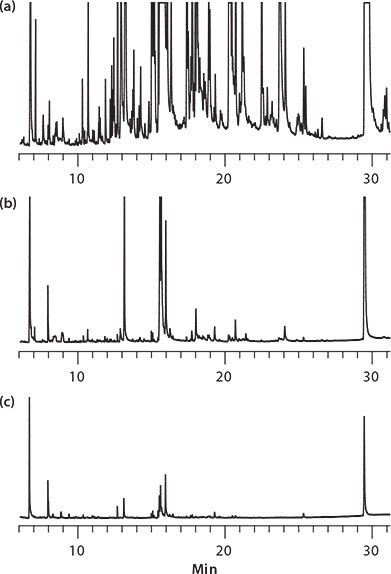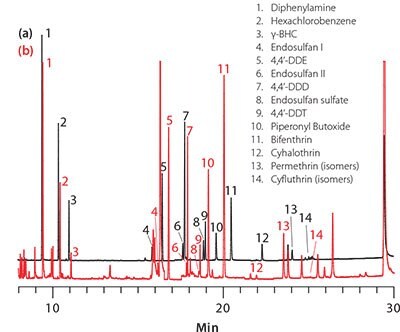Reduce Matrix Background and Improve Overall Analyte Recovery for the Analysis of Pesticides in Beef Kidney
Katherine K. Stenerson, Jennifer Claus
Reporter US Volume 31.1
The exposure of farm animals to agricultural pesticides continues to be a major concern among food producers. For example, in the case of organochlorine pesticides, although their use has been severely restricted by many countries, they can still be detected at low levels in some agricultural products1. Lipophilic pesticides, such as organochlorine and some pyrethroids, can bioaccumulate in fatty tissues, thus finding their way into animal products consumed by the public.
The current methods for extracting pesticides from meat products require the use of organic solvents, consequently resulting in the co-extraction of undesired fatty matrix interferences. Cleanup of samples is then necessary through techniques such as freezing, liquid-liquid partitioning, solid phase extraction (SPE), gel permeation chromatography (GPC), or matrix solid phase dispersion (MSPD) prior to chromatographic analysis1,2.
QuEChERS Cleanup Sorbents
In the past several years, the QuEChERS (Quick, Easy, Cheap, Effective, Rugged, Safe) sample preparation approach has become a very popular method for the extraction and cleanup of fruit, vegetable, and some fatty matrices prior to pesticide residue analysis3-5. The extraction step uses acetonitrile and a salting out effect (with magnesium sulfate). Cleanup is accomplished using dispersive SPE (dSPE), with sorbents such as:
- PSA (primary-secondary amine) – for removal of polar pigments, sugars and organic acids
- Carbon – for removal of chlorophyll and carotenoids
- C18 – for removal of lipids and non-polar components
Typically, for reducing fatty matrix, the combination sorbent Supel™ QuE PSA/C18 is used6. A new cleanup sorbent, Supel QuE Z-Sep+, was recently developed for removal of lipids and pigments. Supel QuE Z-Sep+ is a single material consisting of zirconia and C18 bonded to the same silica particles. The zirconia acts as a Lewis acid, attracting compounds with electron donating groups, such as the -OH in mono and diglycerides, while the C18 binds fats through hydrophobic interaction.
Experimental
In this study, the use of a new sorbent, Supel QuE Z-Sep+ is evaluated and compared to Supel QuE PSA/C18 for removal of fatty components from the beef kidney matrix prior to pesticide residue analysis by GC-MS. Lipophilic insecticides and fungicides common in beef tissues (organochlorines, pyrethroids, diphenyl fungicides and pesticide synergists) are analyzed in this study6,7.
Extraction and cleanup procedures used in this study are based on AOAC® method 2007.01 and summarized below3. Replicates of both unspiked and spiked kidney extract samples were processed. Spiked samples were prepared using a 10 µg/mL mixture of lipophilic pesticides in acetonitrile, spiking at 50 ng/g. Matrix-matched standards were prepared at 10 ng/mL, 20 ng/mL, 40 ng/mL, and 60 ng/mL for each cleanup sorbent. Extracts underwent GC-MS analysis, and quantitation was performed using a calibration curve prepared with matrix-matched standards.
Extraction and Cleanup Procedures
- Place 10 g of a homogenized beef kidney sample into a 50 mL centrifuge tube (Product No. 55248-U). Add 50 µL of a 10 µg/mL spike solution if a spiked replicate.
- Add 25 mL of acetonitrile (Product No. 34481) and shake for one minute.
- Add the contents of an acetate extraction tube (Product No. 55234-U) and shake for one minute.
- Centrifuge for five minutes.
- Transfer 3 mL of the supernatant into the appropriate cleanup tube, Z-Sep+ (Product No. 55296-U) or PSA/C18 (Product No. 55229-U).
- Shake for one minute, then centrifuge for three minutes.
- Inject the extract directly into the GC-MS for analysis.
Matrix Removal
Extracts were run in full scan mode to compare the backgrounds remaining before and after cleanup with Z-Sep+ and PSA/C18 (Figure 1). Heavy matrix observed in the uncleaned sample, consisting primarily of fatty acids, was significantly reduced by both cleanup sorbents. The large peak eluting around 30 minutes, identified as cholesterol, was notably reduced by cleanup. In a direct comparison of the two cleanups, the Z-Sep+ sorbent was found to remove more background than PSA/C18.

Figure 1. GC-MS full scan chromatograms of beef kidney extract (a) with no cleanup (b) PSA/C18 cleanup (c) Z-Sep+ cleanup. All are on the same Y-scale.
GC Conditions
column: SLB®-5ms, 20 m x 0.18 mm I.D., 0.36 µm (Product No. 28576-U); oven: 70 °C (0.5 min), 25 °C/min to 125 °C, 10 °C/min to 200 °C, 5 °C/min to 300 °C (1 min); inj. temp: programmed, 60 °C (0.28 min), 600 °C/min to 325 °C (5 min); detector: MS; carrier gas: helium, 1 mL/min constant;
injection: 10 µL, PTV solvent vent, 100 mL/min vent flow at 0.28 min, 5 psi vent pressure; liner: 4 mm I.D. FocusLiner™ with taper
Chromatography
Consistent with the background comparison study, more matrix remained behind after cleanup with PSA/C18 than Z-Sep+ in the total ion chromatograms (TICs) of the spiked samples run in SIM mode (Figure 2). The matrix enhancement effect was more pronounced in the samples cleaned with PSA/C18, especially for Endosulfan I and II, 4,4’-DDE, piperonyl butoxide, bifenthrin and permethrin.

Figure 2. TICs of GC-MS/SIM Analysis of Pesticides at 50 ng/g in Beef Kidney Extract, Cleaned Using (a) Z-Sep+ and (b) PSA/C18.
Pesticide Recovery
As depicted in Table 2, recoveries for both cleanups fell in the generally acceptable range of 70-120%3. Reproducibility is comparable between both cleanup methods, as shown by the %RSD. Z-Sep+ exhibited higher average recovery values than PSA/C18 for a majority of the pesticides, with the exception of diphenylamine and 4,4’-DDE.
Conclusion
The suitability of the new cleanup sorbent, Supel QuE Z-Sep+, has been successfully demonstrated for cleanup of beef kidney matrix. It was found to effectively reduce background without significantly reducing recovery of lipophilic pesticides such as organochlorines and some pyrethroids. GC-MS full-scan data indicated Z-Sep+ was found to provide better cleanup in the form of reduced background than PSA/C18, and less interference in the GC-MS/SIM analysis of the target pesticides themselves.
如要继续阅读,请登录或创建帐户。
暂无帐户?